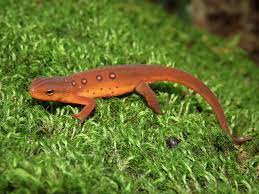The Eastern newt, also known as Notophthalmus viridescens, is a species of salamander native to eastern North America.

It is a member of the family Salamandridae and is well-known for its unique life cycle and distinctive appearance during different stages of its life. Here are some key facts about the Eastern newt:
- Life Cycle: Eastern newts go through three distinct life stages: the aquatic larval stage, the terrestrial eft stage, and the aquatic adult stage. Each stage has different physical characteristics and habitats.
- Larval Stage: After hatching from eggs laid in the water, Eastern newts spend the first few months of their lives as aquatic larvae, commonly referred to as “red efts.” They have feathery external gills and a long tail, enabling them to swim efficiently.
- Eft Stage: As they mature, Eastern newts undergo a transformation into the eft stage. During this stage, which can last for one to three years, they develop a bright orange or red coloration with black spots. Efts are semi-terrestrial, spending most of their time on land but still requiring access to water.
- Adult Stage: After the eft stage, Eastern newts transition back to the water and become fully aquatic. Their coloration changes to a dull olive-green or brown, and the males develop a distinctive tail fin. Adult Eastern newts are more secretive and spend much of their time hiding under rocks or vegetation.
- Habitat: Eastern newts can be found in a variety of aquatic habitats, including ponds, swamps, lakes, and slow-moving streams. They prefer areas with dense vegetation and plenty of hiding places.
- Diet: Eastern newts are opportunistic feeders. Larvae primarily feed on small invertebrates, such as mosquito larvae, while efts and adults consume a variety of small aquatic and terrestrial invertebrates, including insects, worms, snails, and small crustaceans.
- Toxic Defense: Eastern newts possess a unique defense mechanism. Their skin contains tetrodotoxin, a potent neurotoxin, which makes them unpalatable to most predators. However, certain predators, like garter snakes, are resistant to the toxin and can feed on Eastern newts without ill effects.
- Conservation Status: The Eastern newt is not currently considered globally threatened. However, habitat loss, pollution, and the introduction of non-native species can pose risks to their populations.
Remember that specific behaviors, distributions, and characteristics of species can vary within their range, so it’s essential to refer to reputable sources for detailed and region-specific information.